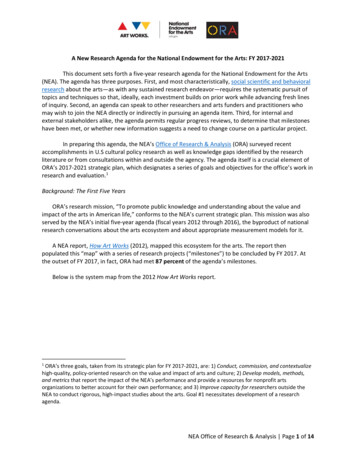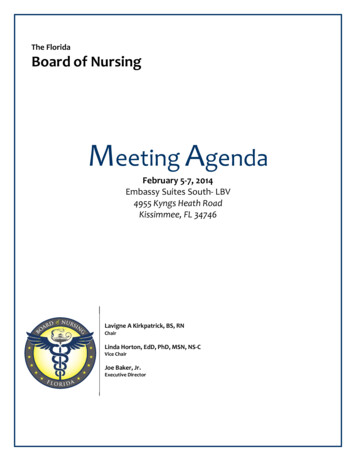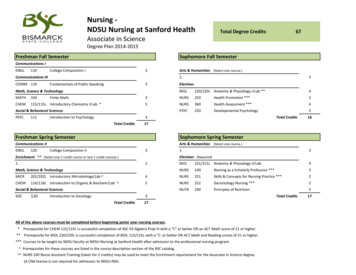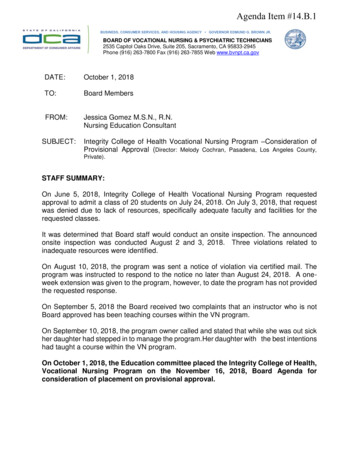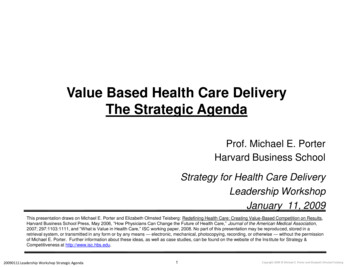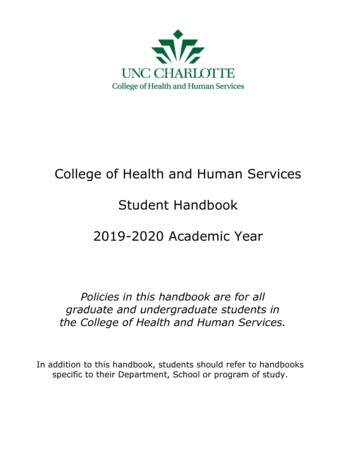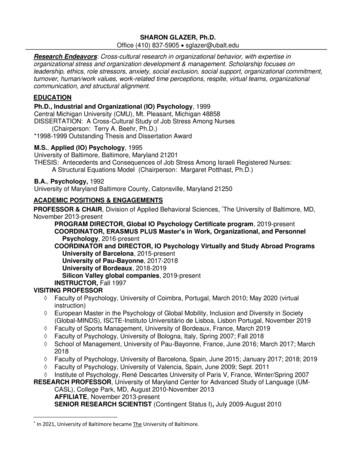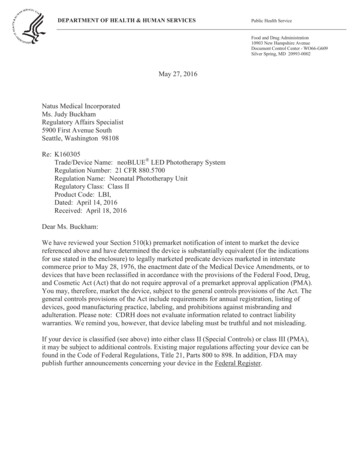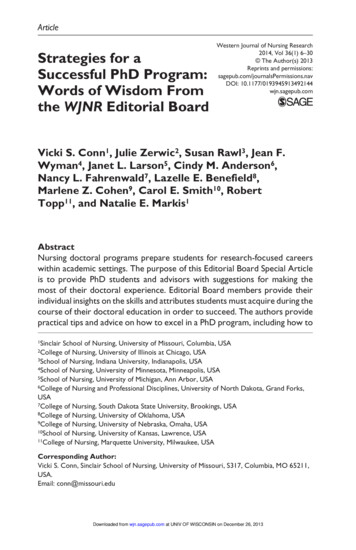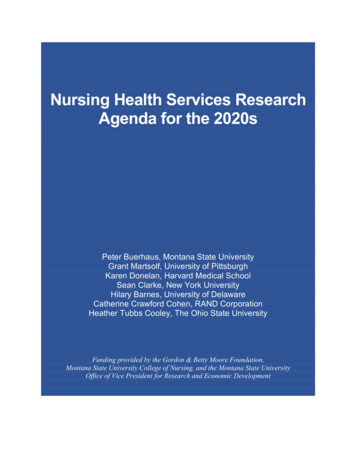
Transcription
Nursing Health Services ResearchAgenda for the 2020sPeter Buerhaus, Montana State UniversityGrant Martsolf, University of PittsburghKaren Donelan, Harvard Medical SchoolSean Clarke, New York UniversityHilary Barnes, University of DelawareCatherine Crawford Cohen, RAND CorporationHeather Tubbs Cooley, The Ohio State UniversityFunding provided by the Gordon & Betty Moore Foundation,Montana State University College of Nursing, and the Montana State UniversityOffice of Vice President for Research and Economic Development
Nursing Health Services Research Agendafor the 2020sIt is imperative to build greater awareness of nursing health services research amongstakeholders, convey the importance of acting on the research agendadescribed in this report, and elicit the support of government andprivate organizations that fund health services researchIntroduction and ContextThe organization, financing and delivery of health care in the United States are facing increasingpressures arising from changes occurring throughout the broader society and from reforms aimedat transforming health care delivery systems. Changes in society are increasing the number ofpeople who need health care and the types of care required. Many of these challenges are welldocumented, such as the aging of the nation’s 77 million baby boomers, many of whom havemultiple co-morbid conditions that exacerbates their medical complexity and increases theintensity and cost of care they require. Similarly, growing numbers of younger-aged people havechronic disease and will live with these conditions for many years. Other challenges stem fromsharp increases in suicide, substance abuse, behavioral health conditions, serious mental healthdisorders, and gun violence. Less well- known challenges involve the worsening health outcomesfor childbearing women and their infants, with minority women bearing a disproportionate shareof perinatal morbidity and mortality.1 Still another challenge concerns the increasing costs ofhealth care which ranks at or near the top of the most important problem facing individuals andfamilies in the U.S.2 Rising costs also mean that federal and state governments must allocate agreater share of their budgets to pay for health care, which reduces the amount of resourcesavailable for other worthwhile social programs. All of these pressures impact and stress healthcare delivery systems, most of which are organized predominantly around providing high costspecialty medical care to treat acute illnesses and cure diseases.Beyond these societal-related challenges, the country’s health care delivery systems are beingtransformed by various reforms that have intensified over the decade. These reforms aim to: Improve the efficiency with which health care delivery systems operate and hold systemsaccountable for costs and qualityExpand access to health careIncrease health education and disease prevention and address social and culturaldeterminants that negatively affect health and well-being3Change the way providers are paid by emphasizing the value of health care services overthe volume of services provided1
NHSR Agenda for the 2020sNovember 2019Responding to these reforms is causing substantial change and uncertainty within health caredelivery organizations and is stimulating educators to examine whether the curricula of healthprofessions are aligned with the direction of reforms. Over the foreseeable future, these societalpressures and health reforms will test health care delivery systems and the health workforce theyemploy, particularly nurses.Nurses and Health Services ResearchThe importance of engaging nurses in addressing these challenges and shaping the future ofhealth care delivery during the 2020s cannot be overstated. As both the largest health workforceand the most trusted of all professions in the country,4 nurses are the glue that hold health caresystems together. Nurse make decisions about the use of costly resources, are involved in patientcare around the clock, are inseparably connected to the quality and safety of care and are amongthe highest paid health professionals. They practice in tens of thousands of healthcare deliveryorganizations, in community settings, schools, prisons and in patients’ homes taking care ofpeople across the lifespan from birth through death. Nurses implement health care education andprevention programs, provide telehealth, and take care of millions of vulnerable people—thosewho are without health insurance, have low income, are dually enrolled in Medicare andMedicaid, are disabled, members of racial minority groups and live in rural and urbanunderserved areas. Nurses also educate the future workforce and conduct clinical and healthservices research to improve individual and population health and improve the delivery of healthcare.Much of the research conducted by nurses focuses on clinical-related studies which seek todevelop, test and refine nursing interventions aimed at improving symptom management ofclinical conditions and improving patient outcomes. The National Institutes of Health NationalInstitute of Nursing Research provides priority setting and funding for much of this research andhas substantially increased the capacity of nurse scientists across the nation. In contrast, nursinghealth services research (NHSR)—the study of health care delivery and systems of care delivery,examination of structures, processes and outcomes of nursing care, evaluating nursing practiceinnovations and new models of care delivery5—has evolved more organically and largelythrough private initiatives. Briefly, key moments in the history of NHSR include: The career of Linda Aiken, who established the University of Pennsylvania Center forHealth Outcomes and Policy Research (CHOPR) and has forged new paths in NHSR inits three decades of existence. Beginning with studies of the original Magnet hospitalsand the outcomes of hospitalized patients with HIV/AIDS in the early 1990s, the work ofCHOPR has unfolded into a rich international program of studies of quality of care,patient and nurse safety, and nurses' work environments on multiple continents. Theirefforts have emphasized leveraging "natural experiments" in the management of nurseworkforces and generating evidence to guide health policy. CHOPR has developed strongeducation programs and continues to train a critical mass of NHSR scholars at thedoctoral and postdoctoral levels. Current and former collaborators and trainees includeEileen Lake, Doug Sloane, Sean Clarke, Jeffrey Silber, Chris Friese, Matthew McHughand many others.2
NHSR Agenda for the 2020sNovember 2019 Peter Buerhaus established postdoctoral programs in NHSR, initially at Harvard Schoolof Public Health in the 1990s and later at Vanderbilt University School of Nursing.During the 2000s, he and Jack Needleman contributed seminal studies providingevidence of the association of hospital inpatient nurse staffing and patient outcomes, withfive contributions designated as “Classics” by the Agency for Healthcare Research andQuality Patient Safety Network. Established by Buerhaus and others in the latter 1990s, the Interdisciplinary ResearchGroup on Nursing Issues (IRGNI) has evolved to become among the most influentialinterest groups within AcademyHealth, the nation’s largest association of health servicesand policy researchers. IRGNI organizes annual meetings that seek to buildinterdisciplinary collaborations, improve the capacity of the nursing workforce to providesafe and effective care, and address gaps in health services research that would benefitfrom nurses’ involvement.6 In 2005, Cheryl Jones and Barbara Mark at the University of North Carolina convened anational meeting of researchers to identify training needs to strengthen NHSR capacity,and develop and disseminate a NHSR agenda.5 Numerous faculty have gained theirpreparation in NHSR at UNC-Chapel Hill under a NINR funded Ruth M. Kirschstein T32 training program. Also, in 2005, the Robert Wood Johnson Foundation launched a program to generate,disseminate, and translate research that is designed to help the public understand hownurses contribute to improving patient care quality. The Interdisciplinary Nursing QualityResearch Initiative program supported 48 interdisciplinary teams of researchers whoconducted rigorous studies linking nursing to patient care processes and outcomes.Interdisciplinary teams of researchers have produced nearly 100 research and evidencebriefs. In 2010 the Institute of Medicine (now the National Academy of Medicine, NAM)published The Future of Nursing: Leading Change, Advancing Health. The reportfocused largely on strengthening the capacity of the nursing workforce and providedrecommendations aimed at improving nursing education, research, policy, andleadership.7 In 2019, the NAM convened a new committee, The Future of Nursing 2020-2030. Thiscommittee is focusing largely on the roles of nurses in addressing the social determinantsof health (SDOH) that negatively affect health and well-being. A report is expected inDecember 2020.83
NHSR Agenda for the 2020sNovember 2019Overview of the Bozeman MeetingIn light of the pressing societal problems affecting the nation’s health, the reforms targetinghealth care delivery systems, the importance of nurses as providers, educators and researchers,and the evolution of NHSR, 38 experts in health services research met in Bozeman, Montana inJuly 2019 to discuss challenges facing health care delivery and develop a NHSR agenda for the2020s. Participants included nurse and non-nurse experts with wide-ranging subject matterexpertise in the fields of health services and social sciences, survey and outcomes research,informatics, health workforce research, economics and policy, as well as physicians, leaders innursing education and public health, and nursing organization executives (Appendix Oneprovides a list of meeting participants). Care was taken to avoid over-representing faculty fromany university or research center. The meeting was planned and organized by Drs. PeterBuerhaus, Grant Martsolf, Karen Donelan, Sean Clarke, Hilary Barnes, Heather Tubbs Cooleyand Catherine (Katie) Cohen. Financial support was provided by the Gordon & Betty MooreFoundation, Montana State University College of Nursing, and Montana State University Officeof the Vice President for Research and Economic Development.Following a review of research agendas developed by public and private organizations that fundresearch, health services research and policy associations that advance the field and advocate forits funding, and health policy leaders, the meeting’s planning leadership reached consensus onfive challenges facing health care delivery where NHSR could make important contributions.These five challenges were used to structure the Bozeman meeting and focus participants onidentifying the key research questions that, if acted upon over the next decade, will generateevidence needed to help:1. Improve access to behavioral health and the effectiveness of interventions and services2. Improve access to primary health care and improve the effectiveness of primary caredelivery systems3. Improve maternal health outcomes and the delivery of maternal health care4. Improve the care provided to the nation’s aging population, particularly frail adults5. Control healthcare spending, reduce costs, and increase the value of nurses’ contributionsto improving health and health care deliveryTwo or three participants were designated to lead the overview and discussion of key issues ineach of the five challenges. Session leaders made brief presentations summarizing what is knownabout each challenge, identified gaps in knowledge, and offered insights into the role of nursesand opportunities and barriers they face conducting research. Following these presentations,participants were assigned to five “breakthrough” groups to discuss specific inputs that influencehealth care systems and care delivery. As shown in Figure 1, these inputs included informaticsand health information technology, the nursing and larger health care workforce, healthcaredelivery systems, payment, and SDOH.4
NHSR Agenda for the 2020sNovember 2019Figure 1: Framework for Identifying a Nursing Health Services Research AgendaChallenges To Health Care System and DeliveryInputs Affecting Health Care System and Delivery Improving access to behavioral health and improving effectiveness ofinterventions for individuals with behavioral and mental health conditions,including care integration, nurses in Accountable Care Organizations (ACOs) andemerging delivery systems and providing suicide, gun violence prevention, andsubstance abuse treatment. Informatics/Health IT - The design, development, adoption, and application of ITbased innovations in healthcare services delivery, management, and planning,including telehealth. Improving access to primary care and improving effectiveness of primary caredelivery systems Overcoming access barriers involving scope of practice, payment,shortages and distribution of primary care providers, and improving theeffectiveness of non-specialized healthcare, especially wellness / primaryprevention activities and delivery systems. Improving maternal health - Care related to sexual and reproductive health,especially prenatal care of women though the first year after pregnancy andaddressing pregnancy-related deaths. This challenge especially concerns care incontext of the social determinants of health and racial/ethnic health disparities. Workforce - The people working within the healthcare sector who deliver or assistin the delivery of health services, particularly RNs and APRNs. This concerns thesupplies of various provider types, maldistribution issues, diversity, and trainingadequacy. Delivery system - The structures and processes that comprise health care deliveryin the U.S. This includes the involvement all health care organizations, professionalgroups, and private and public purchasers. Payment - The structure and processes of reimbursement from public and privatepayers to healthcare delivery systems or providers and how dynamics of thissystem affects incentives for healthcare quality and access. Improving care of the nation’s aging population, including frail elders whosenumbers are growing rapidly. Of particular concern are the frail elderly and forthose living in rural and other underserved areas. Social determinants of health - Conditions in the places where people live, learn,work, and play affect a wide range of health risks and outcomes, including stablehousing, education, income level, neighborhood safety, absence of social isolationand health equity. Helping to control healthcare expenditures, costs, and Increasing the value ofnurses require greater involvement by nurses. Opportunities exist to increasenurses’ value particularly as payment shifts to value based payment modelsKey Questions1.2.3.4.What are the current challenges facing healthcare delivery related to each challenge in terms of each health care input?How can the challenges facing healthcare be addressed by improving aspects of each health care input?What evidence is needed to help stakeholders address challenges facing each challenge, focusing on research in the area of each health care input?How might registered nurses (RNs) and advanced practice registered nurses (APRNs) provide valuable contributions to improve each challengeTaking into account these inputs, participants were charged with identifying the most importantand feasible research questions that need to be answered by NHSR to address each of the fivechallenges over the next 10 years. The breakthrough groups reported their work to the full groupof meeting participants, which then engaged in a thorough discussion before voting on an initiallist of the most important research questions to be undertaken for each of the challenges. On thelast day of the meeting, the full group reviewed the list of research questions for each of thechallenges to ensure the group’s concurrence. Additionally, participants considered topics andideas not covered in earlier sessions, identified target audiences and generated strategies fordisseminating the meeting report.RecommendationsBased on small and large group discussions of gaps in knowledge and analysis of the inputs thatinfluence health care delivery, the following questions were identified as the most feasible andimportant NHSR questions that need to be addressed in each of the five challenges during the2020s.Challenge 1: Improve Access to Behavioral Health and the Effectiveness of Interventionsand ServicesThe opioid epidemic, gun violence, drug addiction, alcoholism, and suicide are increasingproblems confronting health care delivery systems. Better use of APRNs, registered nurses5
NHSR Agenda for the 2020sNovember 2019(RNs) and many other non-physician providers represent important opportunities to helpimprove access to behavioral health and effectiveness of interventions and services.9,10Additionally, integrating behavioral and mental health care into the delivery of primary care,school health and geriatrics, as well as into accountable care organizations and emerging deliverysystems is needed.The following were recommended as the most important and feasible research questions thatneed to be addressed to increase nurses’ ability to improve behavioral health.1. What are the emerging roles and functions of RNs and APRNs providing behavioral andmental health as health care delivery becomes increasingly value-based?2. What are the behavioral health competencies needed for all nurses, RNs and APRNs?3. What are the specific roles and functions of RNs and APRNs providing behavioralhealthcare generally, and how do they vary by severity of behavioral health issues?4. How is team-based care affecting the delivery of behavioral health care, and what is therole of the nurse? What is the optimal configuration of teams to provide effectivebehavioral health care, and what role(s) do nurses play in such teams?5. How are hospitals and healthcare systems using nurses to address SDOH that negativelyaffect health and well-being? What is the role of nurses in addressing these SDOH?Other questions that received support among meeting participants, included: What is the size of workforce shortages in behavioral health and the distribution ofshortages by geography and type of provider?How is behavioral health care being provided in prisons, schools, community and othersettings, and who is providing this care?How can the nursing workforce providing behavioral health care become morerepresentative of the patients they serve?How effectively is telehealth being used to provide behavioral healthcare? Howcompetent are nurses at providing telehealth and how well are nurses being educated andtrained to provide behavioral telehealth?Challenge 2: Improve Access to Primary Care and Improve the Effectiveness of PrimaryCare Delivery SystemsThroughout the US, the need for primary care is growing faster than the capacity of primary carephysicians alone to provide the required care.11 In 2019 the federal government reported that 78million people had inadequate access to primary care.12 To increase access to primary care andimprove the effectiveness of primary care delivery systems, public and private policymakershave recommended greater use of nurses, both at the advanced practice RN (APRN) and RNlevels.13-15 Preparing nurses to provide primary care has emerged as a national workforcepriority.16 This includes increasing nurses’ ability to participate as members or coordinators ofefficient, interdisciplinary teams - either by adapting nurses’ skillsets17 or adjusting staffingmodels to achieve higher efficiency.186
NHSR Agenda for the 2020sNovember 2019The following were recommended as the most important and feasible research questions thatneed to be addressed to improve access to primary
Financial support was provided by the Gordon & Betty Moore Foundation, Montana State University College of Nursing, and Montana State University Office of the Vice President for Research and Economic Development. Following a review of research agenda
